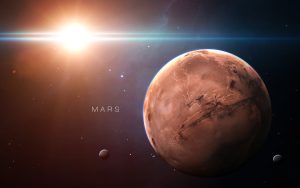Planets and Mars Dichotomy – 6.28am Friday 18th April 2025
Planets and Mars Dichotomy – 6.28am Friday 18th April 2025

Unfortunately, from the limited images of Mars moons I’ve looked at, it’s difficult to determine if they were once part of the same whole. I expect space agencies would have extensive images so would have a clearer idea. If they were a whole, then there may be another piece that went elsewhere.
Since my initial theories about Mars, many have been confirmed.
One of those theories was that Olympus Mons was built that high out of necessity. My view is that planets need to move used material out, volcanically, including unwanted gases. If this is not done on a regular maintenance type basis, it’s likely extremely harmful and probably catastrophic. In the same way that if we were sealed in, the resulting carbon dioxide would be catastrophic for us for example.
I theorised that water was the likely culprit that determined the necessity for Olympus Mons’ extreme height. And there is now evidence for that view, which wasn’t available to me in 2014. (My initial work being 2014.)
We know something profound happened to Mars and the moons definitely indicate possible involvement. A planet with ocean/s and designed to support life, must have a suitable moon for tide and ocean health.
Mars’ hemispheres are very different, including height.
What happened to Mars appears to me to have been an excess of water, that may have found itself without tidal activity.
I believe that water sat for a very long time. If it was global then Mars would look different than it does.
Instead, at some point the majority of this water has covered one hemisphere. Could the core have engineered that? By necessity? Possibly. And that water sat and sat. What movement it would have had is difficult to determine, but weather would have affected it I’m sure. The hemisphere that appears ‘younger’ I don’t think is. The water smoothed and dissolved and eroded. Meteors etc. would have struck water not land, as would have been the case for the other higher rocky hemisphere. This in part, is likely why the hemispheres are different. The core of Mars couldn’t develope properly.
It’s my theory in some instances, where a planets’ magnetic field is highly displaced the core is poorly. It is worth considering that the magnetic field has an association to the state of Mars’ hemispheres.
I do not believe Mars is deceased, but it has suffered from a long term form of failure to thrive.
When we ourselves have failure to thrive, we experience all manner of signs of this and when we are very low on energy, functions and even organs partially shut down so that the essential can go on.
Planets exhibit self maintenance, regardless of supporting life as Earth does, and so it is logical for a planet to do something similar.
An example might be when the pair of poles are struggling, short of energy resource, shut one pole down so the planet can continue with one pole. It will tilt, in my view, but it can survive. No poles and it won’t.
Because of Mars’ poor state, and size, life didn’t get the chance to build there, and through the billions of years it is stunted and struggling, but still alive.
I thought of an analogy, we can go about this planet and mine it for energy resources, on a scale that correlates to our size, in a way that a planet cannot. Likewise, the bee can collect and make honey in a way that we cannot, due again to size and scale.
There isn’t any fossil fuels on Mars. Therefore, Mars has been limited just to its own surrounds. I’m certain though, if calamity hadn’t tragically occurred, Mars would have had life, similar to Earths’, on its surface and would have looked totally different today.
Fiona MacLeod (C)
